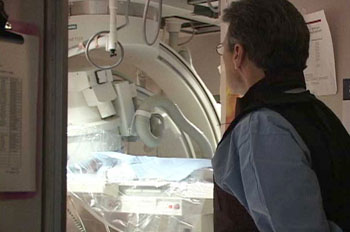Study Reveals Radiologic Procedure Outcomes May Be Affected by Patient Mood
By MedImaging International staff writers
Posted on 29 Dec 2015
New research shows that patients who experienced a high degree of negative feelings such as distress, fear, or hostility before a radiology procedure have significantly more negative side effects than other patients.Posted on 29 Dec 2015
The researchers analyzed data from 230 patients that underwent image-guided interventional radiology procedures and found that those patients that reported a high degree of negative feelings experienced blood pressure and heart rate changes, post-operative bleeding, or other adverse events during or immediately after the procedure that could affect the outcomes of the exam. The research results were presented at the annual Radiological Society of North America (RSNA 2015) meeting in Chicago (IL, USA).

Image: Patient undergoing interventional radiology procedure (Photo courtesy of RSNA).
The patients included 120 women and 110 men with a mean age of 55 years. The procedures investigated were minimally invasive ones such as catheterization. The patients were asked to complete a Positive Affect Negative Affect Schedule (PANAS) survey when they arrived for their procedure. The survey was intended to assess their mood, and used a five-point rating scale to determine whether the patients experienced positive or negative feelings.
The researchers grouped the patients based on their high and low scores for positive and negative effects, and correlated the data with the occurrence of adverse effects such as low or high blood pressure, post-operative bleeding, prolonged lack of oxygen, or an abnormally slow heart rate. The results showed that 22% of the 104 patients with high negative affect (23 patients) had an adverse event, compared to only 15 (12%) of the 126 patients with low negative affect. Patients undergoing such procedures are often conscious but sedated and able to converse with the team of clinicians treating them.
The researchers suggested training healthcare teams in resilience and techniques to improve their own positive emotional states, and that of the patients prior to the procedure.
Dr. Lang, interventional radiologist in Boston, Massachusetts, USA, said, "You don't need to have a chipper, cheery attitude prior to your procedure. You just have to overcome negative emotions and get to a neutral level. This is a real issue. The procedure room is a two-way street in which the patient can affect the healthcare professional and vice versa. Any time the team must manage an adverse event, it takes attention away from the procedure. We need to help staff show patients how to manage their own emotions to help create an environment for a better outcome.”
Related Links:
RSNA













